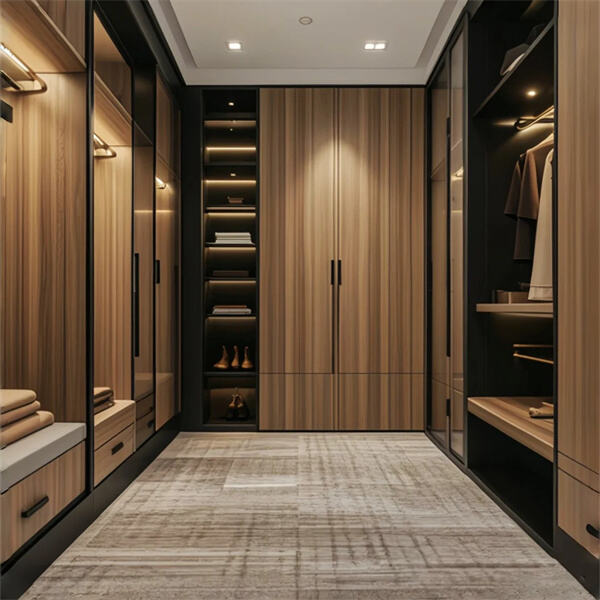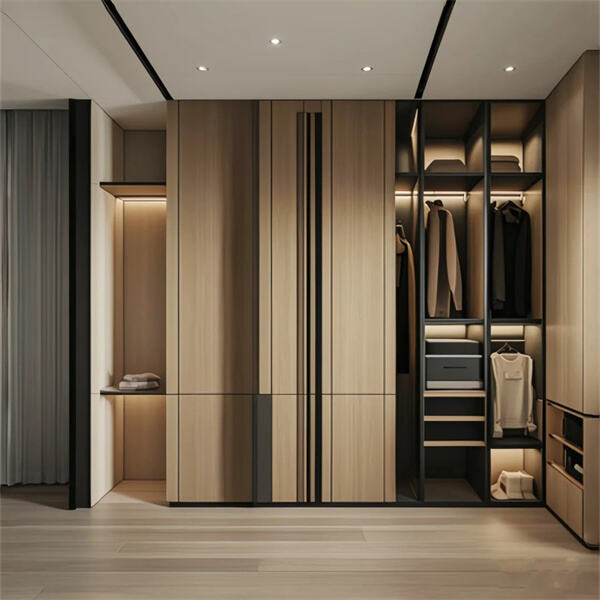Tips for Wardrobe Interior Layout Design
A wardrobe is one of the most important storage elements in any home. Beyond its role as a place to keep clothes, accessories, and shoes, a well-designed wardrobe interior layout can enhance organization, maximize space, and make everyday dressing more convenient. A poorly planned wardrobe often leads to clutter, wasted space, and frustration when trying to locate items. With the right planning, however, a wardrobe can be customized to reflect both functional and aesthetic needs.
In this guide, we will explore essential tips for wardrobe interior layout design, considering everything from structural elements and storage solutions to aesthetics and personalization. By the end, you will have a comprehensive understanding of how to design a wardrobe that not only looks good but also functions effectively.
The Importance of Wardrobe Interior Layout
A wardrobe is more than just a storage cabinet. It is a personalized system designed to accommodate lifestyle needs. The layout determines how efficiently clothes, shoes, accessories, and other belongings are organized. With an optimized design, it is possible to maximize available space, minimize clutter, and streamline daily routines. A well-planned wardrobe interior also ensures better care of garments, keeping them in good condition for longer.
Assessing Your Storage Needs
The first step in designing a wardrobe interior layout is understanding your storage requirements. Consider the type of clothes and accessories you own and how often you use them. A wardrobe for someone with a business wardrobe full of suits and dresses will look very different from a wardrobe designed for a casual lifestyle with more jeans and t-shirts.
Take inventory of your belongings. Count how many shoes you have, how many long coats require full hanging space, and how many small accessories like ties, belts, and jewelry you need to store. By knowing exactly what needs to be accommodated, you can tailor the wardrobe to meet those needs rather than adopting a one-size-fits-all approach.
Planning Hanging Space
Hanging space is one of the most important parts of a wardrobe. Long hanging sections are essential for coats, dresses, and gowns, while short hanging areas work best for shirts, jackets, and trousers. If your wardrobe allows, consider dividing it into both types. Double hanging rods can maximize vertical space by allowing two rows of shirts or shorter garments.
For more flexibility, adjustable rods are ideal since they allow you to adapt the wardrobe as your clothing collection changes. Adding pull-down rods for higher sections makes it easier to access clothes without wasting space.
Optimizing Shelves
Shelves are versatile storage solutions within a wardrobe. They are perfect for folded clothes, handbags, and accessories. Adjustable shelves give you the ability to reorganize the space as your storage needs evolve.
Deep shelves can store bulky items like sweaters, while shallow shelves are better for items like t-shirts or accessories that need to remain visible. To avoid clutter, avoid shelves that are too wide or too deep, as items may get lost at the back. Incorporating dividers can also help keep stacks of clothing neat and organized.
Incorporating Drawers
Drawers are essential in a wardrobe interior for smaller items. They keep belongings dust-free and hidden from view, making the wardrobe look tidier. Shallow drawers are perfect for storing undergarments, ties, socks, and jewelry, while deeper drawers can hold sweaters, jeans, or workout clothes.
Adding organizers within drawers improves functionality. Jewelry inserts, for instance, prevent tangled necklaces, while compartment trays ensure that smaller accessories like watches or cufflinks remain easy to find. Soft-close drawers also add a touch of luxury while minimizing noise.

Shoe Storage Solutions
Shoes often take up significant space, and without proper organization, they can quickly create clutter. A dedicated shoe section within the wardrobe makes storage more efficient. Adjustable shoe racks or angled shelves make it easier to view and access shoes. Pull-out shoe drawers are also a practical option, keeping pairs neatly aligned.
For larger collections, a vertical shoe tower within the wardrobe ensures maximum use of space. Seasonal shoes can be stored on higher shelves, while everyday pairs should remain at an easily accessible height.
Accessory Organization
Accessories like belts, ties, scarves, and jewelry require dedicated spaces in a wardrobe. Hanging racks, pull-out trays, and small drawers are excellent for organizing these items. Hooks on the inside of wardrobe doors can also be used for scarves or belts, making use of otherwise wasted space.
For jewelry, consider a lockable drawer with compartments for rings, necklaces, and bracelets. This not only keeps items secure but also helps prevent damage. Accessories are often overlooked in wardrobe design, but allocating specific storage areas ensures they are well-organized and easily accessible.
Lighting for Function and Aesthetics
Lighting is an essential aspect of wardrobe interior design. Without proper lighting, even the best-organized wardrobe can feel impractical. LED strip lights along shelves, sensor-activated lights inside drawers, or overhead spotlights can improve visibility and create a more luxurious feel.
Well-placed lighting makes it easier to find items, especially in deep wardrobes or darker corners. Warm lighting adds elegance, while cool lighting enhances visibility. Choosing energy-efficient LED options ensures both sustainability and cost savings.
Using Sliding or Hinged Doors
The choice between sliding and hinged doors affects wardrobe design. Sliding doors save space and are ideal for small rooms, but they may limit full visibility of the wardrobe interior at one time. Hinged doors allow complete access but require more clearance space.
Mirrored doors serve a dual purpose, adding functionality while making rooms appear larger. Glass doors can showcase clothing collections, while solid doors keep everything hidden for a more minimalist look. The decision depends on the available room size and the desired aesthetic.
Maximizing Vertical Space
Wardrobe interiors should make full use of vertical height. The topmost areas can store seasonal or rarely used items in boxes or bins. Installing pull-down hanging rods or step-access shelves ensures this space is not wasted. Custom cabinetry that extends from floor to ceiling provides maximum storage while giving a seamless appearance.
Incorporating Custom Features
A wardrobe can be tailored with custom features that match individual needs. For example, a wardrobe designed for an athlete may include ventilated sections for sportswear, while a wardrobe for a fashion enthusiast may feature glass display cabinets for handbags and accessories.
Custom features can also include built-in laundry hampers, pull-out ironing boards, or hidden safes. These specialized additions increase convenience and make the wardrobe more than just a storage unit—it becomes a personalized lifestyle solution.
Materials and Finishes
The choice of materials and finishes influences both the durability and the appearance of a wardrobe. Solid wood provides a classic and long-lasting option, while engineered wood offers affordability and versatility. Laminates, veneers, and high-gloss finishes can enhance the style, depending on whether the wardrobe should blend in or stand out.
Eco-friendly materials such as bamboo or reclaimed wood are also gaining popularity. Finishes that are easy to clean and maintain are ideal for busy households. The choice should balance aesthetics, durability, and sustainability.
Wardrobe Layout for Shared Spaces
When designing wardrobes for shared spaces, such as master bedrooms, it is important to allocate distinct sections for each person. Dividing hanging areas, shelves, and drawers ensures both users have adequate storage and prevents clutter. Custom layouts allow partners to have storage tailored to their personal clothing and accessory collections.
In children’s wardrobes, adjustable shelves and rods allow the layout to grow with them. Safety features, such as soft-close drawers and secure fittings, are also essential.
Wardrobe Trends for Modern Homes
Wardrobe design trends in recent years have emphasized functionality, minimalism, and personalization. Open-concept wardrobes, where clothes are visible, are increasingly popular in walk-in spaces. Modular wardrobes that can be expanded or reconfigured provide flexibility. Neutral colors and sleek finishes dominate modern aesthetics, though bold accents are used to personalize interiors.
Integrated technology is also a trend. Smart wardrobes may include automated lighting, digital inventory systems, or climate control features to keep clothes fresh. These innovations reflect the growing demand for wardrobes that not only store belongings but also improve lifestyle convenience.
Conclusion
A well-designed wardrobe is more than a storage solution; it is an essential part of daily life that reflects organization, style, and efficiency. By carefully planning the wardrobe interior layout, homeowners can ensure that every inch of space is used effectively while keeping items accessible and well-protected. From hanging space and drawers to lighting and finishes, each element contributes to a functional and aesthetically pleasing design.
The choice of layout should reflect personal needs, whether it is maximizing shoe storage, incorporating custom features, or creating space for accessories. A thoughtfully designed wardrobe improves not only the appearance of a room but also the user’s daily routine.
FAQ
What is the most important factor in wardrobe interior layout design?
The most important factor is assessing personal storage needs. Understanding the type and quantity of clothes and accessories helps create a layout that suits your lifestyle.
Should I choose sliding or hinged doors for a wardrobe?
Sliding doors are ideal for small rooms since they save space, while hinged doors allow full access to the wardrobe interior. The choice depends on available space and design preferences.
How can I maximize space in my wardrobe?
Maximizing space involves using double hanging rods, adjustable shelves, pull-out drawers, and making use of vertical height with storage boxes or pull-down rods.
Are custom wardrobes worth the investment?
Yes, custom wardrobes offer tailored storage solutions, improve organization, and enhance the overall look of a room, making them a worthwhile investment.
What materials are best for wardrobe interiors?
Durable options include solid wood, engineered wood, laminates, and eco-friendly materials like bamboo or reclaimed wood. The choice depends on budget, style, and sustainability goals.
Table of Contents
- The Importance of Wardrobe Interior Layout
- Assessing Your Storage Needs
- Planning Hanging Space
- Optimizing Shelves
- Incorporating Drawers
- Shoe Storage Solutions
- Accessory Organization
- Lighting for Function and Aesthetics
- Using Sliding or Hinged Doors
- Maximizing Vertical Space
- Incorporating Custom Features
- Materials and Finishes
- Wardrobe Layout for Shared Spaces
- Wardrobe Trends for Modern Homes
- Conclusion
- FAQ

